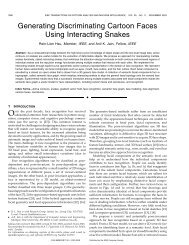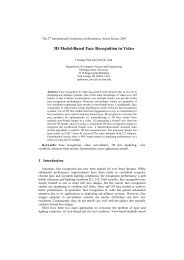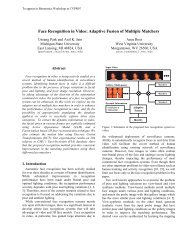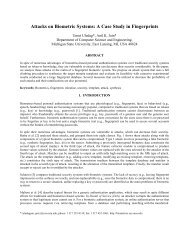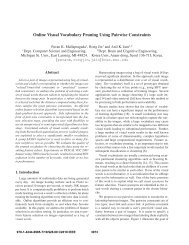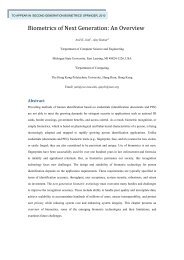Face Detection and Modeling for Recognition - Biometrics Research ...
Face Detection and Modeling for Recognition - Biometrics Research ...
Face Detection and Modeling for Recognition - Biometrics Research ...
Create successful ePaper yourself
Turn your PDF publications into a flip-book with our unique Google optimized e-Paper software.
such as eyes, mouth <strong>and</strong> face boundary. The main properties of this algorithms are<br />
listed as follows.<br />
• Lighting compensation: This method corrects the color bias <strong>and</strong> recovers<br />
the skin-tone color by automatically estimating the reference white pixels in a<br />
color image, under the assumption that an image usually contains “real white”<br />
(i.e., white reference) pixels <strong>and</strong> the dominant bias color in an image always<br />
appears as “real white”.<br />
• Non-linear color trans<strong>for</strong>mation: In literature, the chrominance components<br />
of the skin tone have been assumed to be independent of the luminance<br />
component of the skin tone. We found that the chroma of skin tone depends on<br />
the luma. We overcome the difficulty of detecting the low-luma <strong>and</strong> high-luma<br />
skin tone colors by applying a nonlinear trans<strong>for</strong>m to the Y C b C r color space.<br />
The trans<strong>for</strong>mation is based on the linearly fitted boundaries of our training<br />
skin cluster in Y C b <strong>and</strong> Y C r color subspaces.<br />
• <strong>Modeling</strong> a skin-tone color classifier as an elliptical region: A simple<br />
classifier which constructs an elliptical decision region in the chroma subspace,<br />
C b C r , has been designed, under the assumption of the Gaussian distribution of<br />
skin tone color.<br />
• Construction of facial feature maps <strong>for</strong> eyes, mouth, <strong>and</strong> face boundary:<br />
With the use of gray-scale morphological operators (dilation <strong>and</strong> erosion),<br />
we construct these feature maps by integrating the luminance <strong>and</strong> chrominance<br />
in<strong>for</strong>mation of facial features. For example, eye regions have high C b (difference<br />
29



